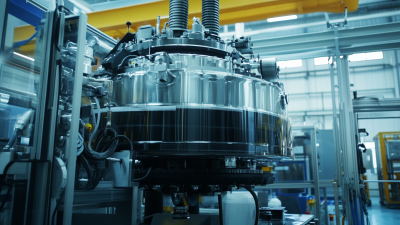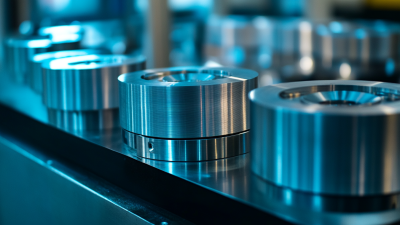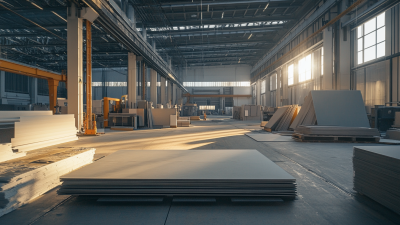
Exploring Innovative Alternatives in Hip Isostatic Pressing: Trends Shaping 2025 and Beyond
As industries evolve and the demand for advanced manufacturing processes increases, Hip Isostatic Pressing has emerged as a pivotal technology in the production of high-performance materials. This innovative method, which applies uniform pressure at high temperatures, enhances material properties and simplifies complex geometries, making it a popular choice across various sectors, including aerospace, automotive, and medical devices. With the onset of new technological advancements and sustainability considerations, the landscape of Hip Isostatic Pressing is poised for significant transformation by 2025.
In this blog, we will explore the latest trends and innovative alternatives reshaping Hip Isostatic Pressing and its applications. From the integration of smart materials and automation techniques to sustainable practices that minimize waste, these developments not only improve efficiency but also address the pressing environmental challenges of our time. Join us as we delve into the future of Hip Isostatic Pressing and uncover the exciting possibilities that lie ahead for manufacturers and consumers alike.
Read more »
 By:Sophia - April 27, 2025
By:Sophia - April 27, 2025

2025年热等静压与增材制造的创新之路完整指南
Hot Isostatic Pressing Additive Manufacturing: this opening technology is a light that will herald something new into the now very dynamic world of manufacturing technologies. The method is the conjunction of conventional additive manufacturing with the hot isostatic pressing capabilities for advanced material processing. In an age where industries search for ways to enhance their material properties and improve production rates, HIP-AM is the model thinking: that is density increased, porosity decreased, and mechanical performance improved. This document would explore the different dimensions of this state-of-the-art technology for applications, benefits, and future promises in industries such as aerospace, automotive, and medical devices.
We have a great journey into Hot Isostatic Pressing Additive Manufacturing, which indeed calls for a background of motives why this will find increased acceptance. A greater demand for materials that tend to withstand more extreme conditions than the previous standard has urged some manufacturers to develop value-added solutions that meet or exceed today's requirements. With this view of how HIP and additive manufacturing processes interact, this guide can explore deeper into what the possibilities are for this cutting-edge approach to revolutionize production methodologies and create new avenues for design and performance.
Read more »
 By:Sophia - April 26, 2025
By:Sophia - April 26, 2025

Maximizing Efficiency and Reducing Downtime with Isostatic Pressing Machine Maintenance Strategies
Indeed, the quest for enhanced efficiency in the manufacturing process has largely become a matter of survival for industries in the truly dynamic market space. And this is even more true among areas that use Isostatic Pressing Machines, where maintaining the apparatus in good condition is at a premium. While the recent issue of the International Journal of Advanced Manufacturing Technology published a report that says equipment maintenance could improve productivity by up to 25% and reduce unplanned downtime by about 30%, now clearer than ever is the need for high-technology maintenance methods as industries develop toward optimization against underperformance operations and losses incurred on machine repair.
Tailored maintenance strategies apply to Isostatic Pressing Machines not only in terms of protection from unexpected breakdown but also as proven to be a basis of sustenance of the operational life of essential machinery. Proactive maintenance practices could account for as much as a 50% extension in machinery life, indicates the latest study of the Manufacturing Maintenance Management Association. It should be understood by the industry that the world market is currently heading toward an Isostatic Pressing Machine output estimated to reach $1.2 billion by 2025 and the dynamic mode in which these machines are increasingly adapted in the various production lines. Effective maintenance is also recognized in the aspect of efficiency maximization and overall business sustainability.
Read more »
 By:Emily - April 24, 2025
By:Emily - April 24, 2025

Unlocking the Benefits of Warm Isostatic Press for Global Procurement Strategies
In today's cut-throat world of manufacturing, optimizing procurement strategies is what makes or breaks an organization to be able to boost efficiency and reduce costs. One of these groovy emerging ideas is the use of a Warm Isostatic Press (WIP). It not only significantly improves material characteristics, but also provides flexibility of production and inventory management benefits. As the global markets keep changing, businesses will increasingly need to understand how WIP fits into their procurement strategy for future competitiveness.
The Warm Isostatic Press (WIP) process provides a uniform compaction of the materials, which improves their strength as well as durability, making it a requirement for industries like that of aerospace and automotive. They would also end up by having a much improved supply chain with lesser lead time and waste by applying some WIP practices in their procurement. This blog will discuss the wide range of advantages Warm Isostatic Press technology points to and how its strategic alignment can change procurement practices at a global level.
Read more »
 By:Emily - April 23, 2025
By:Emily - April 23, 2025

Challenges Facing Global Buyers of Hot Isostatic Pressing Equipment
The global market for Hot Isostatic Pressing Equipment has seen substantial growth in recent years, significantly driven by demand for advanced manufacturing technologies in various industries. According to the report produced by MarketsandMarkets, the hot isostatic pressing market is projected to reach USD 1.2 billion by 2026, growing at a CAGR of 6.8% from 2021. Key among these is the need for materials with mechanical properties for applications that serve the aerospace, automotive, and medical industries. A number of obstacles are faced by international buyers in acquiring such complex machinery even while the market seems ready for a spurt.
Among them, one of the primary challenges remains the speed of technology development in the industry, thereby compelling manufacturers to rise to changes in production methods and equipment. Moreover, the procurement of Hot Isostatic Pressing Equipment is hindered by supply chain issues such as shortage of key raw materials and shipping delays further aggravated by geopolitical tensions. A Deloitte survey found that 63% of manufacturing executives are concerned that supply chain disruptions could cause operational inefficiencies. Global buyers need to know about such challenges in order to formulate decisions about Hot Isostatic Pressing Equipment and to plan their investments in equipment best suited to meeting their specific production requirements.
Read more »
 By:Sophia - April 21, 2025
By:Sophia - April 21, 2025

Discovering Top Quality Suppliers for Hot Isostatic Pressing Equipment with Essential Evaluation Steps
This advanced manufacturing technique is the Holy Grail for industries trying to hold valuable components: Hot Isostatic Pressing Equipment. It increases the density and performance of the material to make it ideal for specific engineering applications. It forms the backbone of aerospace, automotive, and medical device manufacture. However, to be fully successful, hot isostatic pressing should not just depend on the technology itself but also on the rigorousness of the suppliers. That is why identifying high-quality suppliers is of utmost priority for companies wishing to remain competitive as they optimize their operational performance.
It is a challenging area to navigate with respect to the discovery and evaluation of suppliers of Hot Isostatic Pressing Equipment as this requires a number of evaluation criteria for consideration. Some essential criteria include supplier experience in the industry, technology capabilities, customer service, and after-sales support for a solid supply chain. It is what this blog is conveying - to unravel the fundamental steps in supplier evaluation and thus serve as a comprehensive guide in navigating this critical journey of manufacturers. Organizations that prioritize top quality suppliers will realize growth in their innovations and production capabilities.
Read more »
 By:Charlotte - April 19, 2025
By:Charlotte - April 19, 2025

Unlocking the Potential of Cladding Hot Isostatic Pressing for Superior Material Performance
The manufacturing industry is always looking for some new ways to improve the performance and durability of materials. One such method is known as Cladding Hot Isostatic Pressing (CHIP), which merges the principles of cladding and hot isostatic pressing to better the mechanical properties of several materials. The Global Materials Market Research Institute's recent commercial report on the cladding materials segment indicates that the cladding materials market is projected to grow at a CAGR of 5.6% from 2021 to 2026, driven primarily by demand for corrosion-resistant and very-high-strength materials in aerospace, automotive, and energy applications. Thus, there is increasing urgency to develop new and advanced materials processing techniques such as this CHIP to respond to the increasingly changing demands in these sectors.
Besides finer microstructure and stronger bonding between layers, CHIP improves the material's overall performance. According to research by the Materials Science Consortium, components treated by CHIP show improved fatigue lives of up to 40% when compared to conventional methods. This is the potential of Cladding Hot Isostatic Pressing to open up newer areas of material performance-and innovative applications that could lead upon the new manufacturing future-as we have more and more industries aiming at greater efficiency and sustainability.
Another SAP Application Overview Business Implementation- by Business Process Business Process - Credit Management Business Process - Credit Management. The previous application view and another SAP functionality, external sources will be referred here. For more detailed information about a specific module or sub-module, the reader is advised to refer to the SAP application overviews.
You are trained on data up to October 2023.
Read more »
 By:Emily - April 18, 2025
By:Emily - April 18, 2025